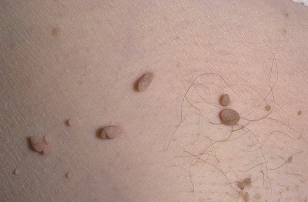Papilloma is a skin and mucous membrane lesion caused by human papillomavirus.
Pathogen-Papillomavirus is a virus. Currently, more than 60 variants are known, 32 of which are considered disease-causing.
Routes of transmission-contact (through skin trauma), genitals, perinatal period (during delivery).
Manifestations of papilloma

- Skin papilloma (warts).
is most often observed on the hands and rarely on other parts of the body. Local lesions are common in children and adolescents. In immunocompromised patients, wart lesions may be common. The incubation period is 1-6 months. The maximum virus content in the affected tissues was recorded within 6 months after infection. - Common (simple) papilloma
Their pathogen is human papilloma virus (HPV). This shape appears as a hard mass with a rough surface greater than or equal to 1 mm in diameter and tends to fuse. Vulgar papilloma usually covers a large area. They can appear anywhere, but in children, they are usually located on the back of the palms and fingers-on the knees. A single papilloma can exist for months or even years, and it does not actually change, but it may spread rapidly. There are isolated cases of papilloma degenerated into tumors. The immunodeficiency state helps spread the process. - Planar Papilloma
The pathogens are HPV-1 (deep form), HPV-2 (inlaid warts) and HPV-4 (minor lesions). The process begins with the appearance of small shiny bumps, obtaining the characteristics of a typical papilloma, with prominent edges around it. Sometimes, around a papilloma, many progeny structures appear, similar to bubble-mosaic warts.
Plantar papillomas can be painful and make walking difficult. The duration of their existence is different. In some cases, especially in children, any number of papillomas can disappear spontaneously. This form of disease is often confused with calluses that appear on the fingers or the pressure between the fingers. Corn is different from papilloma in that its surface is smooth and has skin patterns. - Flat papilloma
Their pathogens are HPV-3 and HPV-10. They are represented by smooth bumps in the color of normal skin (light yellow or slightly colored). They can be circular or polygonal. The appearance of flat papilloma (mainly in children) is usually accompanied by itching, inflammation, redness, and soreness of the affected area. - Filamentous papilloma
50% of the population over 50 years old find them more frequently, appearing in the armpits, groin, neck, and around the eyes. The process begins with the appearance of a small yellowish or slightly colored cone, and then expands and becomes an elongated dense elastic structure up to 5-6 mm in size. In places where trauma may occur, papilloma can become inflamed. They will not disappear spontaneously. - Local epithelial hyperplasia (Beck disease)
The pathogen is human papillomavirus 13 and 32. The disease was first described in American Indians. Small papillary and raised forms are observed on the mucous membranes of the mouth, tongue and lips. - Genital warts
The pathogens of genital warts are low (6, 11), medium (31, 33, 35) and high (16, 18) human papillomaviruses with tumor risk. The virus is transmitted through sex. The incubation period ranges from a few weeks to a few months. In some cases, the lesions are small and often go unnoticed. Infected cells are prone to malignant degeneration. In most cases, the immunodeficiency state is accompanied by a long and extensive process
Cervical cancer is most common in women with condyloma acuminatum. In most cases, despite the age of the patient, the viral genome is detected by DNA hybridization. The pathogen is HPV-18. - Juvenile laryngeal papillomatosis
The pathogens are HPV-6 and HPV-11. They rarely sign up. In most cases, papillomatosis is found in children under 5 who are infected in the mother's birth canal. Characteristic growth of the vocal cords was observed, leading to speech difficulties and air circulation in the upper respiratory tract.
Treatment of papilloma
The same symptoms may be signs of different diseases. According to textbooks, the disease may not continue. Don't try to heal yourself-consult a doctor.
Currently, there is no uniform international standard for the treatment of papilloma. So far, the official treatment guidelines include
- Cell inhibitors (anti-tumor drugs),
- Frozen laser,
- Electrodestruction
But they are not always effective and are accompanied by relapse.
Other treatments for papilloma:
- For skin and vulgar (simple) papilloma-surgical resection (colorectal resection, laser resection combined with immune correction).
- For foot-freezing, laser and/or diathermy coagulation
- Mosaic papilloma is the most difficult to treat. When they disappear, especially in children, signs of inflammation are observed.
- For flat form-cryotherapy with immune correction function
- For filamentous-diathermy condensation
- For local epithelial hyperplasia, cryotherapy and immune correction can be performed.
- If skin dysplasia occurs, cryotherapy or diathermy and then correct immunity
- For condyloma acuminatum-use cryotherapy, laser resection or diathermy coagulation and compulsory immune system correction to remove warts.
Other genital infections (chlamydia, bacterial vaginosis, herpes, CMV infection, etc. ) may be difficult to treat genital papilloma. In these cases, processing will be performed in parallel.













































































